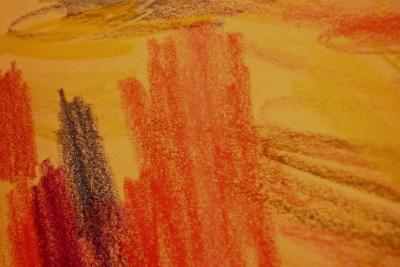The Art and Soul of Note-booking
“The beautiful messy notebook is at the heart of all my work. Most of it is never seen by anyone but myself,” says MA Writing for Young People Professor, David Almond.
Pen and ink are part of the Imagineer’s toolkit. Mark-making on paper is elemental: there’s a visceral connection between your mind and the pen in your hand, as you engineer a story using your imagination. Adding colour elicits a child’s point-of-view, is playful, and there’s great freedom in the serendipity of mistakes. I was excited to find that note-booking is strongly encouraged on the Bath Spa MA Writing for Young People course.
How do we begin? Just doodle!
Artist Paul Klee’s famous description of drawing as “simply a line going for a walk” provides a wonderful way to approach a blank page. I’ll often just doodle before writing words, or in the spaces between words, in the margins. The inky line becomes, almost of its own accord, a character, a geometric shape, a creature, a word, a sentence and then, usually, a whole page of writing.
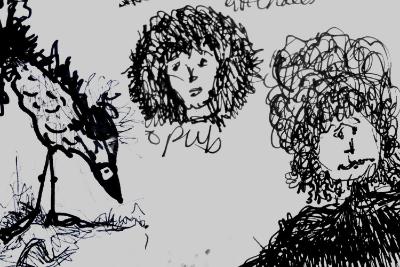
Author and MA lecturer Elen Caldecott says:
“Any picture, image, wiggly line is fine, the pencil/pen just needs to keep moving across the page, without pausing to look around, or to worry that the doodle is no good.”
After this simple beginning, she recommends moving on to free writing.
It’s important to feel you can write anything you like in your notebook. You don’t have to share it with anyone else unless you want to. Don’t forget Morning Pages, a kind of journaling described by Julia Cameron in her book The Artist’s Way. As the name suggests, these pages are to be written as soon as you wake up, writing whatever comes into your head. It’s a great stimulus to creativity, sluicing the mind of accumulated detritus, and leaving the driftwood of curious ideas behind, ready to be discovered.
Hoard your treasures!
My own notebooks are scrappy, half-formed things, but I love and keep them all – they’re full of ideas to be explored and recycled. Some aren’t even books – they’re merely bits of paper, scribbled-on train tickets, or paper napkins, whereas others are too beautiful to mess up, and linger, barely touched on the shelf: shiny-papered Miss Havishams, waiting forever for their day of glory.
Author and MA WFYP graduate Rowena House says:
“There's a glorious moment when I think a story idea is ready to graduate from scruffy paper outlining to a proper, hard bound, beautiful notebook, and I think: Yes! Here we go. But given the number of half-filled notebooks I now own, I suspect that moment is actually an illusion…”
My real favourites are my 50p exercise books. Writing in these is like drinking tea in your pyjamas on a rainy day: if you spill the tea, it really doesn’t matter. These books are for new ideas, rhymes, random scenes and rough plotting. I can bend the covers, tear pages out, scribble on them – anything.
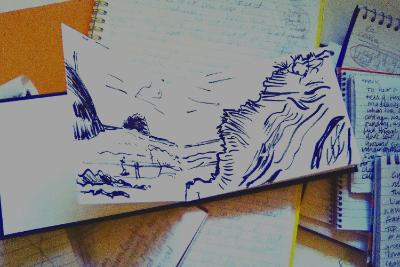
Black-covered sketchbooks from the art store are ideal for writing and sketching outside, around the city or on the beach. You might choose one particular book for your work-in-progress: I wrote everything, from snatches of overheard conversations to unicorn sketches, ideas, scenes and tutor notes in an orange vinyl-covered budget book I chanced upon in Bath. It was a perfect fit.
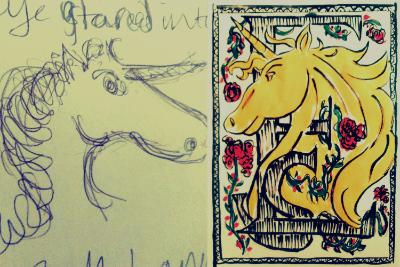
Colouring, cutting, and sticking
I’m intrigued by virtual scrapbooks, with their endless possibilities for notes, images and quotes saved to the cloud or on a PC or phone, but I can’t imagine living without real ink on actual paper.
And making a paper scrapbook of found images, poetry, quotes and notes is another sort of tactile note-booking. Really good for people who like cutting and sticking, which is probably most of us! Here’s a beautiful page from MA WFYP graduate Anna Crowe, for her manuscript The Lake.
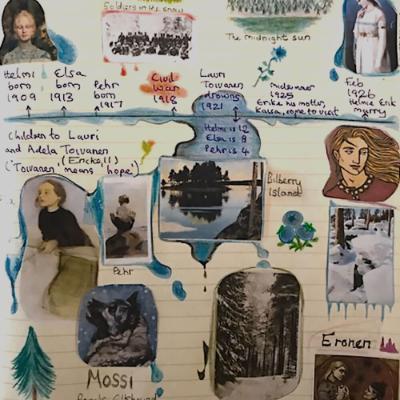
Just do it!
Write your dream fragments early in the morning, write those brilliant plot solutions that wake you in the middle of the night; hold conversations with a character; draw a map, a sketch, a doodle, stick in a photograph, or make up a recipe for magic chocolate cake… the practice will deepen, strengthen and stretch your narrative ability, just as physical exercise trains your body.
“Notice things. Listen lots,” says Professor Julia Green. “Write things down that you think and feel and see and hear and touch.”
It’s your book, it’s a playground for your imagination, where you can write and draw and dance like nobody is watching. So don’t wait, just do it – take your line for a walk!
